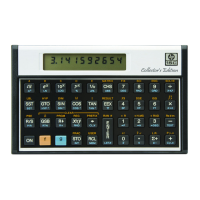Section 14: Numerical Integration 203
In the preceding example, the uncertainty indicated that the
approximation might be correct to only four decimal places. If we
temporarily display all 10 digits of the approximation, however, and
compare it to the actual value of the integral (actually, an approximation
known to be accurate to a sufficient number of decimal places), we find
that the approximation is actually more accurate than its uncertainty
indicates.
Keystrokes Display
®
1.3825 00
Return approximation to
display.
´ CLEAR u
1382459676
All 10 digits of approximation.
The value of this integral, correct to eight decimal places, is 1.38245969.
The calculator’s approximation is accurate to seven decimal places rather
than only four. In fact, since the uncertainty of an approximation is
calculated very conservatively, the calculator’s approximation, in most
cases will be more accurate than its uncertainty indicates. However,
normally there is no way to determine just how accurate an approximation
is.
For a more detailed look at the accuracy and uncertainty of f
approximations, refer to Appendix E.
Using f in a Program
f can appear as an instruction in a program provided that the program
is not called (as a subroutine) by f itself. In other words, f cannot be
used recursively. Consequently, you cannot use f to calculate multiple
integrals; if you attempt to do so, the calculator will halt with
Error 7
in
the display. However, f can appear as an instruction in a subroutine
called by _.
The use of f as an instruction in a program utilizes one of the seven
pending returns in the calculator. Since the subroutine called by f
utilizes another return, there can be only five other pending returns.
Executed from the keyboard, on the other hand, f itself does not utilize
one of the pending returns, so that six pending returns are available for
subroutines within the subroutine called by f. Remember that if all
seven pending returns have been utilized, a call to another subroutine will
result in a display of
Error 5
. (Refer to page 105.)

